Eiichiro Sakata – Enoshima
July 13 (Saturday) – September 29 (Sunday), 2013
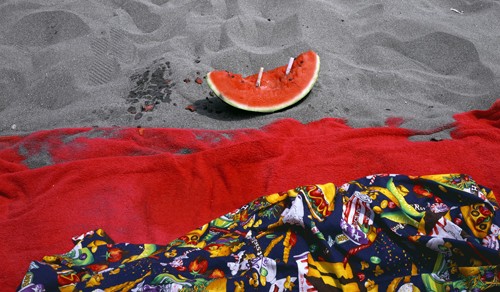
Enoshima 1999 ⓒ Eiichiro SAKATA
The Hara Museum of Contemporary Art is pleased to present the first public showing of Eiichiro Sakata’s Enoshima, a photo series comprised mainly of landscapes encountered by the famed photographer during visits to Enoshima. Sakata, a master of portrait photography, began taking photos of summer beach goers at the seaside resort south of Tokyo during the latter half of the 1990s. The results after 16 years of shooting are vibrant portraits of Japanese youth and vivid still-lifes of their various belongings lying casually on picnic sheets, scenes that may be thought of as ″portraits without people.″ Together, they show the truly variegated character and rapidly changing face of contemporary Japan. In total, some 40 color photographs will be shown (including about 10 portraits). “I hope people living in these complicated and unpredictable times will feel a positive energy in these images of young people, and that that energy will lift up their spirits.″ Instilled in the exhibition is the sincere hope for the future, of a photographer who through his full engagement with his subjects and his sharp and perceptive eye has captured and recorded the genuine spirit of his times.
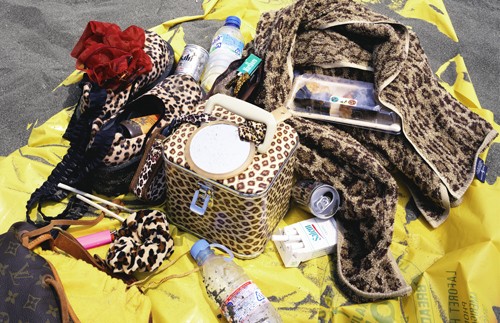
Enoshima 1998 ⓒ Eiichiro SAKATA
Exhibition Details
Title: Eiichiro Sakata – Enoshima
Dates: July 13 (Saturday) – September 29 (Sunday), 2013
Place: Hara Museum of Contemporary Art 4-7-25 Kitashinagawa, Shinagawa-ku, Tokyo 140-0001
Tel: 03-3445-0651 E-mail: info@haramuseum.or.jp
Museum website: http://www.haramuseum.or.jp Mobile site: http://mobile.haramuseum.or.jp
blog: https://www.art-it.asia/en/u/HaraMuseum_e (blog) Twitter: http://twitter.com/haramuseum
Organized by: Hara Museum of Contemporary Art
Sponsored by: Nikon Corporation, Nikon Imaging Japan inc.
Cooperation provided by: Shashin Kosha, EIZO Corporation
Number of works: Approximately 40 including about 10 portraits
Hours: 11:00 am – 5:00 pm, Wednesdays until 8:00 pm (last entry 30 minutes before closing)
Closed: Mondays (open on July 15, September 16 and 23), July 16, September 17 and 24
Admission: General 1,000 yen; Students 700 yen (high school and university) or 500 yen (elementary and junior high); Free for Hara Museum members, students through high school every Saturday during the school term; 100 yen discount per person for groups of 20 or more.
Directions: 5 minutes by taxi or 15 minutes on foot from JR Shinagawa Station (Takanawa exit); or from the same station take the No.96 bus, get off at the first stop (Gotenyama), and walk 3 minutes
[Related Event]
Artist Talk: Eiichiro Sakata
Date: Saturday, July 20 3:00 to 4:30 pm
Place: The Hall at the Hara Museum of Contemporary Art
Seating limit: 80 persons
Fee: Free (entrance admission will be required: general 1,000 yen, students 700 yen)
Reservations will be accepted by e-mail on a first-come, first-served basis.
Email address: event@haramuseum.or.jp
*Please indicate “Artist Talk: Eiichiro Sakata” on the subject line and your name, names of accompanying persons and contact phone number in the body of the e-mail.
*Reservationa are now closed.
For inquiries, please contact the Hara Museum at: Tel: 03-3445-0651
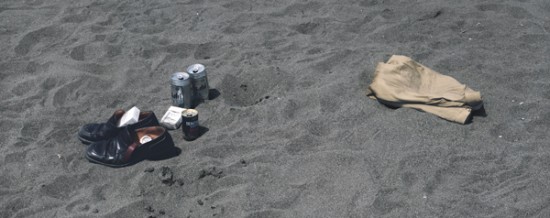
Enoshima 1997 ⓒ Eiichiro SAKATA

Enoshima 2007 ⓒ Eiichiro SAKATA
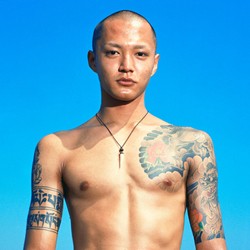
Enoshima 2007 ⓒ Eiichiro SAKATA
Artist Profile
Eiichiro Sakata was born in Tokyo in 1941 and graduated from Nihon University College of Art with a degree in photography. He worked at the advertising company Light Publicity Co., Ltd., whose list of many creators included the likes of Ikko Tanaka, Makoto Wada, and Kishin Shinoyama. In 1966, Sakata went to New York to study at the studio of the photographer Richard Avedon. In 1970, he held his first solo exhibition Just Wait at Ginza Nikon Salon in Tokyo. In 1993, he was invited to the Arles Photo Festival in France, a large international event within the photography world, where he also conducted workshops. He was made an honorary citizen of Arles in 1993. Among the general public, Sakata is most widely known for his portraits of notable figures that appear on the cover of the weekly magazine AERA (published by Asahi Shimbun). Without a break, Sakata has produced more than 1,000 cover portraits for the magazine since its debut in 1988. In 2004, he held the solo exhibition PIERCING THE SKY at the Tokyo Metropolitan Museum of Photography. In 2005, he was the recipient of the 24th Domon Ken Award and Lifetime Achievement Award of the Photographic Society of Japan. For his work, Sakata uses 8×10, 4×5 and 6×6 cameras and always shoots on film.
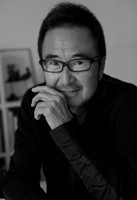
Eiichiro Sakata
List of Publishing
1985 Chumon-no-Ooi Shashinkan, Ryuko Tsushin
1990 Talking Faces, Rikuyosha
1995 amaranth, Asahi Shimbun
2004 PIERCING THE SKY, Kyuryudo
2006 JUST WAIT, Kyuryudo
2008 LOVE CALL – PORTRAIT OF THE AGE, Asahi Shimbun
Message from Eiichiro Sakata on the Occasion of the Exhibition
Over the course of 16 years, from 1997 to 2012, I made regular trips to the beaches of Enoshima to take photographs. I felt something special in the atmosphere of this island dedicated to the worship of the goddess Benten, one of the Seven Gods of Good Fortune. It was a place where crowds of lively young people gathered from all corners of Japan, as if drawn by some magnetic force.
One time in 1997, while walking on a beach with my 8×10 camera, I was struck by the landscape I saw there, a landscape consisting of the various belongings of the beach visitors casually lying on the beach. Designer bags, stuffed trinkets, shoes, half-finished drinks – possessions from which one could glean a clear image of their owners and a strong sense of presence. I felt that these scenes were clearly ″portraits.″ It was a feeling that jolted me. Growing up with the ability to multitask, these young people led busy lives, simultaneously listening to music as they drank, ate, smoked, put on makeup, jumping up and running off to a public phone whenever their pagers buzzed, or, as cell phones came on the scene, chatting with friends, taking photos and texting. These were uniquely modern-day Japanese scenes unlike any other place in the world. There was also a loneliness that drifted through these scenes, one which seemed to symbolize a chaotic age in which people are comfortable, yet hectic; affluent, yet unfulfilled.
I was at the beach one day and had been shooting for a while when I met a young girl. As we talked, I was extremely drawn to her aura and felt a very strong life force within her. She let me take her portrait (plate 4). That was how I began taking portraits of young people at Enoshima.
I was surprised by the change in the beach landscape that occurred as time went by. Even after the collapse of the bubble economy during the 1990s, Enoshima retained its well-seasoned and energetic charm. But the character of the things on the beach became more plain, more subdued with each passing year. I continued snapping tons of photographs with the same fervor as before, but there were times when I couldn’t come up with even a single acceptable image.
I take photographs in order to come face to face with the energy being emitted by people, to take it in and to rejuvenate my own spirit with it. I want to convey a message to society through my photographs. I hope people living in these complicated and unpredictable times will feel a positive energy in these images of young people, and that that energy will lift up their spirits.
——————————————————-
TO ALL VISITORS
To help protect the works of art on view, we ask that you follow the precautions listed below.
■Do not touch the artwork.
■Preschool children should be held by the hand while inside the galleries.
REGARDING PHOTOGRAPHY
■Photography is not allowed inside the museum with the exception of the exhibition Eiichiro Sakata – Enoshima in Gallery II (on the first floor) where photography has been allowed by artist consent.
■Due to copyright issues, we ask that you refrain from taking photos of the artworks installed on the outside grounds of the museum.
PLEASE OBSERVE THE FOLLOWING PROHIBITIONS
■No close-up photography.
■No use of flash, tripod or unipod .
■No video recording.
■No photographing of other visitors.
■Use of photos for commercial or other secondary purposes that infringe on copyright is strictly prohibited.
